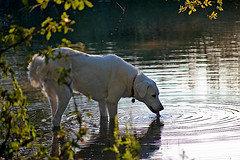FDA implements new strategic plan to protect pets and humans against antibiotic-resistant microbes

flickr photo courtesy of kretyen
Animals need to take antibiotics, just like humans, when the need arises, and veterinary doctors are just as careful in prescribing them. Antibiotic resistance can just as easily affect pets. One primary caveat with this scenario: Salmonella bacteria — which affects the gut — that has become resistant to life-saving antibiotic drugs.
The National Antimicrobial Resistance Monitoring System (NARMS) is a national public health surveillance system that tracks antibiotic resistance in foodborne bacteria and was created in 1996.
Children, the elderly and those suffering from immunosuppression are most at risk from enteric bacteria like Salmonella, Campylobacter, Escherichia coli and Enterococcus and those pathogens have been the focus of NARMS research.
Non-typhoidal Salmonella and Campylobacter are the leading bacterial causes of foodborne illness in the United States.
Salmonella, as you are probably aware, has been the source of pet food recalls in the recent past, and our very young and very old pets are most susceptible to the bacteria, and suffer the effects most profoundly. The most common symptoms associated with salmonella are vomiting, diarrhea and fever. Companion animals presenting with symptoms are treated with IV fluids and antibiotics.
Cathy Theisen, DVM, a mobile veterinary doctor serving the Ann Arbor area, elaborates further. "It really depends on how much previous exposure to that strain of salmonella the dog has. Your average active dog has wolfed down goose poop, horse manure, drank and swum in infected ponds, and eaten half rotten road kill — all of which provided a likely dose of salmonella bacterium. Those dogs are often effectively immune, having been exposed to nonlethal doses over a lifetime."
While this gives some level of immunity, it's important to remember that there are different strains of salmonella and your pet has likely not been exposed to all of them. Keeping that in mind, it's important to first of all keep on top of reported pet food recalls and not allow your pet to consume things that is infected by the bacteria — regardless of the source.
"That said," Theisen continues, "I would never knowingly feed a dog a diet infected with salmonella. This may be high doses of the bacteria and also a strain of bacteria that the dog hasn't encountered in its local environment. If the dog is susceptible, the consequences can be quite severe, and even fatal, especially for dogs who have no previous exposure. If the dog is showing symptoms, it should be treated immediately."
For that reason, it's important that antibiotics maintain their effectiveness against salmonella.
In an effort to improve the safety of food and try and keep the issue of drug resistant bacteria that affects the gut in check, NARMS unveiled their strategic plan in January.
For more information on the FDA's role in veterinary medicine, click here.
As always, you can keep up to date on all reported pet food recalls on the AnnArbor.com pet section.
Lorrie Shaw is a regular contributor to AnnArbor.com's pet section and owner of Professional Pet Sitting. Contact her by e-mail and follow her pet adventures on Twitter.


Comments
FattyJ
Wed, Feb 9, 2011 : 5:33 a.m.
Thoroughly afraid! We need the FDA to step in and save us!
Edward Vielmetti
Tue, Feb 8, 2011 : 7:42 p.m.
NARMS: <a href="http://www.cdc.gov/narms/" rel='nofollow'>http://www.cdc.gov/narms/</a> "NARMS is a collaboration among Centers for Disease Control and Prevention (CDC), U.S. Food and Drug Administration (Center for Veterinary Medicine) and U.S. Department of Agriculture (Food Safety and Inspection Service and Agricultural Research Services)
hiphopopotamus
Tue, Feb 8, 2011 : 7:40 p.m.
I am confused by your headline. You mention the FDA's strategic plan but it is not explained in the article. The link you have is for the National Antimicrobial Resistance Monitoring System's strategic plan. Are they part of the FDA or are they an independent watchdog? These are important things to know since this is a serious issue. I hope our government is finally doing something about the overuse of antibiotics, especially in animals, such as the cattle. I had hoped to gain a little knowledge about the plan rather than have to follow links for the info the headline mentioned.